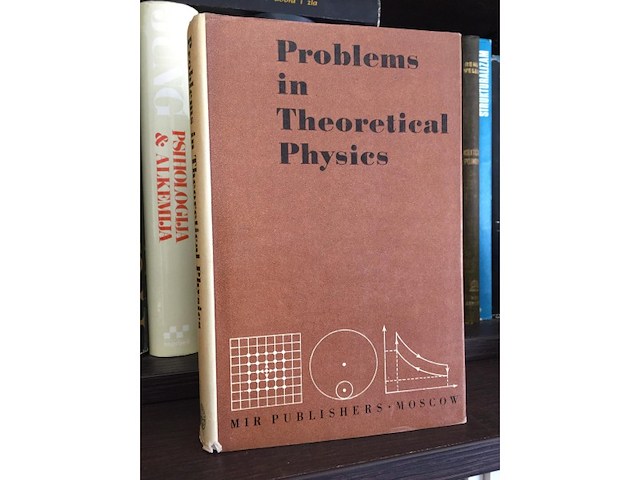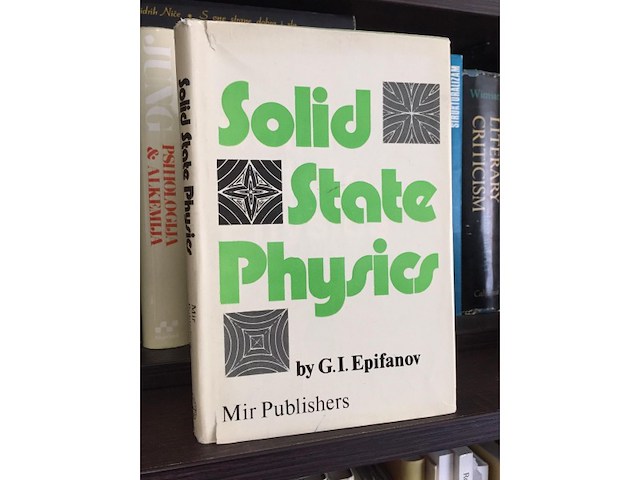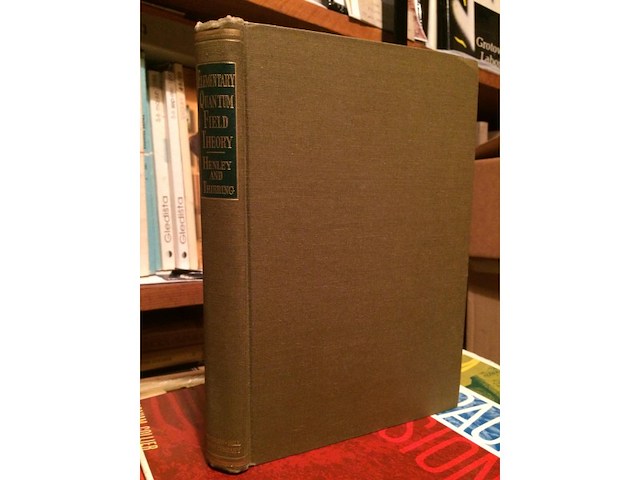Pratite promene cene putem maila
- Da bi dobijali obaveštenja o promeni cene potrebno je da kliknete Prati oglas dugme koje se nalazi na dnu svakog oglasa i unesete Vašu mail adresu.
1-3 od 3 rezultata
Broj oglasa
Prikaz
1-3 od 3
1-3 od 3 rezultata
Prikaz
Prati pretragu "fizika 7"
Vi se opustite, Gogi će Vas obavestiti kad pronađe nove oglase za tražene ključne reči.
Gogi će vas obavestiti kada pronađe nove oglase.
Režim promene aktivan!
Upravo ste u režimu promene sačuvane pretrage za frazu .
Možete da promenite frazu ili filtere i sačuvate trenutno stanje
Lepo očuvano Problems in Theoretical Physics Grechko, L. G., V.I. Sugakov and O.F. Tomasevich: Published by MIR, Moscow, 1977 Contents PREFACE 5 Section I. Classical Mechanics 9 Problems 25 Answers 141 Section II. Electrodynamics 50 Problems 61 Answers 160 Section III. Quantum Mechanics 78 Problems 92 Answers 230 Section IV. Statistical Physics and Thermodynamics 110 Problems 119 Answers 356 APPENDICES 424 1. Basic formulas of vector analysis 424 2. Curvilinear coordinates 425 3. Differential operators in curvilinear coordinates 429 4. Mathematical supplement 434 5. Legendre polynomials 441 6. Hermite polynomials 444 7. The confluent hypergeometric junction 446 BOOKS ON THE SUB1ECT 448 RETKO! RARE! This book is a collection of problems covering mechanics, electrodynamics, nonrelativistic quantum mechanics, !statistical physics and thermodynamics. Each Section opens with a brief outline of the main laws and relationships used to solve the problems. Also information about the needed mathematical apparatus is included. Along with answers there are guides to solving the more complicated problems. SI units are used throughout the book. Problems in Theoretical Physics is intended for physics majors at universities and other institutions of higher learning. Some of the problems are specifically for students majoring in theoretical physics. Certain ones can be used in the physics and mathematics departments of teachers colleges. From the Preface The text draws largely on the Course of Theoretical Physics by L. D. Landau and E. M. Lifshitz, but also makes use of other textbooks and handbooks recommended for the university course in theoretical physics. Some of the problems have been taken from published problem books listed at the end of this book, but many are original. The student will be able to solve the problems if he has a good knowledge of the fundamentals of theoretical physics, which are briefly outlined in each section of this book. Tags: Problemi teorijske fizike / Teorijska fizika moskva izdanja na engleskom
Lepo očuvano Solid State Physics by G. I. Epifanov ( Mir Publishers Moscow, 1979, Hardcover ) Author: G. I. Epifanov, D.Sc. Publisher: Mir Publishers, Moscow. Title: Solid State Physics. Printed in: Moscow, Russian Federation. Edition 1st English Edition 1979 info: This is a book which covers the topic of solid state physics comprehensively. Starting from the structure of matter and various types of bonds in the first chapter the mechanical properties are treated in the second chapter. The second chapter also includes a discussion of Hooke`s Law, plastic flow, dislocations, elasticity etc. The third chapter deals with statistical mechanics and discusses degenerate and non-degenerate ensembles and various distribution functions. The fourth chapter looks at thermal properties of solids with reference to crystal lattice, heat capacity, heat conductivity etc. The fifth chapter discusses band theory of solids with reference to energy spectrum, effective mass and semiconductors. Some of the graphs in this chapter are revealing of the physical processes in the working of band structure. Sixth and seventh chapter deal with electrical and magnetic properties of solids. Sixth chapter also discusses deviations from Ohm`s Law (Section 58). Seventh chapter includes discssion on various types of magnetism their origins, and magnetic properties of solids and atoms along with magnetic resonance. Eighth chapter discusses contact phenomenon, work functions between different of materials including p-n junctions. The last chapter discusses thermoelectric and galvanomagnetic phenomena including Seeback effect, Peltier effect, Thomson effect and some of their practical applications. As in the first edition, the presentation of material has followed the aim of elucidating the physical nature of the phenomena discussed. But, where possible, the qualitative relations are also presented, often though without rigorous mathematics. The book was translated from the Russian by Mark Samokhvalov and was published by Mir in 1979. Contents Preface 5 1 Bonding. The Internal Structure of Solids § 1 The van der Waals forces 11 § 2 The ionic bond 15 § 3 The covalent bond 16 § 4 The metallic bond 21 § 5 The hydrogen bond 22 § 6 Comparison between bonds of various kinds 23 § 7 Forces of repulsion 24 § 8 Crystal lattice 25 § 9 Notation used to describe sites, directions, and planes in a crystal 29 §10 Classification of solids based on the nature of bonds 32 §11 Polymorphism 38 §12 Imperfections and defects of the crystal lattice 42 2 Mechanical Properties of Solids § 13 Elastic and plastic deformations. Hooke’s law 46 § 14 Principal laws governing plastic flow in crystals 51 § 15 Mechanical twinning 55 § 16 Theoretical and real shear strengths of crystals 56 § 17 The dislocation concept. Principal types of dislocations 58 § 18 Forces needed to move dislocations 64 § 19 Sources of dislocations. Strengthening of crystals 66 § 20 Brittle strength of solids 71 § 21 Time dependence of the strength of solids 77 § 22 Methods of increasing the strength of solids 81 3 Elements of Physical Statistics § 23 Methods used to describe the state of a macroscopic system 84 § 24 Degenerate and nondegenerate ensembles 88 § 25 The number of states for microscopic particles 91 § 26 Distribution function for a nondegenerate gas 94 § 27 Distribution function for a degenerate fermion gas 96 § 28 Distribution function for a degenerate boson gas 103 § 29 Rules for statistical averaging 105 4 Thermal Properties of Solids § 30 Normal modes of a lattice 107 § 31 Normal modes spectrum of a lattice 110 § 32 Phonons 112 § 33 Heat capacity of solids 115 § 34 Heat capacity of electron gas 120 § 35 Thermal expansion of solids 122 § 36 Heat conductivity of solids 126 5 The Band Theory of Solids § 37 Electron energy levels of a free atom 133 § 38 Collectivization of electrons in a crystal 136 § 39 Energy spectrum of electrons in a crystal 138 § 40 Dependence of electron energy on the wave vector 142 § 41 Effective mass of the electron 147 § 42 Occupation of bands by electrons. Conductors,dielectrics, and semiconductors 151 § 43 Intrinsic semiconductors. The concept of a hole 153 § 44 Impurity semiconductors 156 § 45 Position of the Fermi level and free carrier concentration in semiconductors 159 § 46 Nonequilibrium carriers 166 6 Electrical Conductivity of Solids § 47 Equilibrium state of electron gas in a conductor in the absence of an electric field 169 § 48 Electron drift in an electric field 170 § 49 Relaxation time and mean free path 171 § 50 Specific conductance of a conductor 173 § 51 Electrical conductivity of nondegenerate and degenerate gases 174 § 52 Wiedemann-Franz-Lorenz law 176 § 53 Temperature dependence of carrier mobility 177 § 54 Electrical conductivity of pure metals 183 § 55 Electrical conductivity of metal alloys 184 § 56 Intrinsic conductivity of semiconductors 188 § 57 Impurity (extrinsic) conductivity of semiconductors 190 § 58 Deviation from Ohm’s law. The effect ofa strong field 193 § 59 The Gunn effect 195 § 60 Photoconductivity of semiconductors 196 § 61 Luminescence 203 § 62 Fundamentals of superconductivity 207 7 Magnetic Properties of Solids § 63 Magnetic field in magnetic materials 224 § 64 Magnetic properties of solids 225 § 65 Magnetic properties of atoms 232 § 66 Origin of diamagnetism 238 § 67 Origin of paramagnetism 240 § 68 Origin of ferromagnetism 247 § 69 Antiferromagnetism 254 § 70 Ferrimagnetism. Ferrites 255 § 71 Magnetic resonance 257 § 72 Fundamentals of quantum electronics 259 8 Contact Phenomena § 73 Work function 265 § 74 Contact of two metals 268 § 75 The metal-semiconductor contact 271 § 76 Contact between two semiconductors of different types of conductivity 278 § 77 Physical principles of semiconductor p~n junction devices 288 § 78 Fundamentals of integrated circuit electronics (microelectron ics) 299 9 Thermoeleletric and Galvanomagnetic Phenomena § 79 The Seebeck effect 302. § 80 The Peltier effect 307 § 81 The Thomson effect 310 § 82 Galvanomagnetic phenomena 310 § 83 Practical applications of thermoelectric and galvanomagnetic phenomena 315 Appendices I Derivation of the Maxwell-Boltzmann distribution function 317 II Derivation of the Fermi-Dirac distribution function 318 III Derivation of the Bose-Einstein distribution function 320 IV Tables 321 Glossary of Symbols and Notations 322 Bibliography 326 Index 329 Fizika strucna literatura iz fizike naucne knjige prirodne nauke
odlično stanje U teorijskoj fizici, kvantna teorija polja je teorijski okvir koji kombinuje klasičnu teoriju polja, specijalnu relativnost i kvantnu mehaniku[1] i koristi se za konstrukciju fizičkih modela subatomskih čestica (u fizici čestica) i kvazičestica (u fizici kondenzovane materije). Kvantna teorija polja tretira čestice kao pobuđena stanja (koja se nazivaju i kvanti) njihovih temeljnih polja, koja su, u određenom smislu, fundamentalnija od osnovnih čestica. Interakcije između čestica opisane su pojmovima interakcije u Lagranžijanovoj teoriji polja koja uključuje njihova odgovarajuća polja. Svaka interakcija može biti vizuelno predstavljena Fajmanovim dijagramima, koji su formalni računski alati u procesu relativističke teorije perturbacija. Kao uspešan teorijski radni okvir danas, kvantna teorija polja proizašla je iz rada generacija teorijskih fizičara 20. veka. Njen razvoj je počeo 1920-ih sa opisom interakcija između svetlosti i elektrona, kulminirajući u prvoj kvantnoj teoriji polja - kvantnoj elektrodinamici . Velika teorijska prepreka ubrzo je usledila sa pojavom i postojanošću raznih beskonačnosti u perturbativnim proračunima, problem koji je rešen tek pedesetih godina prošlog veka izumom renormalizacijske procedure. Druga velika prepreka bila je očigledna nesposobnost kvantne teorije polja da opiše slabe i jake interakcije, do te mere da su neki teoretičari tražili napuštanje teorijskog pristupa. Razvoj teorije kalibra i završetak Standardnog modela 1970-ih doveli su do renesanse kvantne teorije polja. Teorijska osnova Uredi Linije magnetnog polja vizualizovane upotrebom gvožđa. Kada je komad papira posut gvozdenim strugotinama i postavljen iznad magnetnog šipka, strugotine se poravnavaju prema smeru magnetnog polja, formirajući lukove. Kvantna teorija polja je rezultat kombinacije klasične teorije polja, kvantne mehanike i posebne relativnosti.[1] Najstarija uspešna klasična teorija polja je ona koja je nastala iz Njutnovog zakona univerzalne gravitacije, uprkos potpunoj odsutnosti koncepta polja iz njegovog traktata iz 1687. godine Matematički principi prirodne filozofije. Sila gravitacije koju opisuje Njutn je „akcija na daljinu” - njeni efekti na udaljene objekte su trenutni, bez obzira na udaljenost. Matematički fizičari su tek u 18. veku otkrili prikladan opis gravitacije na osnovu polja - numeričke veličine (vektor) dodeljene svakoj tački u prostoru koja ukazuje na delovanje gravitacije na bilo koju česticu u toj tački. Međutim, ovo se smatralo samo matematičkim trikom. [2] Polja su počela da preuzimaju sopstveno postojanje sa razvojem elektromagnetizma u 19. veku. Majkl Faradej je 1845. skovao engleski termin „polje” (engl. field). On je unosio polja kao svojstva prostora (čak i kada je lišen materije) koja imaju fizičke efekte. On se protivio „akciji na daljinu` i predložio da se interakcije između objekata odvijaju kroz „linije sile” koje ispunjavaju prostor. Ovaj opis polja ostaje do danas.[3][4][5] Teorija klasičnog elektromagnetizma završena je 1862. godine sa Maksvelovim jednačinama, koje su opisale odnos između električnog polja, magnetnog polja, električne struje i električnog naboja. Maksvelove jednačine podrazumevale su postojanje elektromagnetnih talasa, fenomen gde se električna i magnetska polja šire iz jedne prostorne tačke u drugu pri konačnoj brzini, koja ispada da je brzina svetlosti. „Akcija na daljinu” je tako konačno odbačena.[3] Uprkos ogromnom uspehu klasičnog elektromagnetizma, nije mogao da uzme u obzir diskretne linije u atomskom spektru, niti raspodelu zračenja crnog tela u različitim talasnim dužinama.[6] Plankovo istraživanje zračenja crnog tela označilo je početak kvantne mehanike. On je tretirao atome, koji apsorbuju i emituju elektromagnetno zračenje, kao sitne oscilatore sa ključnim svojstvom da njihove energije mogu da preuzmu samo niz diskretnih, a ne kontinuiranih vrednosti. Oni su poznati kao kvantni harmonički oscilatori. Ovaj proces ograničavanja energije na diskretne vrednosti zove se kvantizacija.[7] Na osnovu ove ideje, Albert Ajnštajn je predložio 1905. godine objašnjenje za fotoelektrični efekat, da se svetlost sastoji od pojedinačnih paketa energije koji se nazivaju fotoni (kvant svetlosti). To implicira da elektromagnetno zračenje, dok su talasi u klasičnom elektromagnetnom polju, takođe postoji u obliku čestica.[6] Nils Bor je 1913. godine uveo Borov model atomske strukture, pri čemu elektroni unutar atoma mogu preuzeti samo niz diskretnih, a ne kontinuiranih energija. Ovo je još jedan primer kvantizacije. Borov model uspešno je objasnio diskretnu prirodu atomskih spektralnih linija. Godine 1924. Luj de Broj je predložio hipotezu o dualnosti talasa i čestica, da mikroskopske čestice pokazuju osobine i talasa i čestica u različitim okolnostima.[6] Ujedinjavanje ovih raspršenih ideja, koherentna disciplina, kvantna mehanika, formulisana je između 1925. i 1926. godine, sa važnim doprinosima de Broja, Vernera Hajzenberga, Maksa Borna, Ervina Šredingera, Pola Diraka i Volfganga Paulija.[2]:22-23 Iste godine kada je izašao i njegov rad o fotoelektričnom efektu, Ajnštajn je objavio svoju teoriju posebne relativnosti, izgrađenu na Maksvelovom elektromagnetizmu. Nova pravila, nazvana Lorencova transformacija, data su za način na koji se vremenske i prostorne koordinate događaja menjaju pod promenama brzine posmatrača, a razlika između vremena i prostora je zamagljena.[2]:19 Predloženo je da svi fizički zakoni moraju biti isti za posmatrače pri različitim brzinama, tj. da su fizički zakoni invarijantni pod Lorencovim transformacijama. Ostale su još dve teškoće. Šredingerova jednačina, na kojoj se temelji kvantna mehanika, mogla bi objasniti stimulisanu emisiju zračenja iz atoma, gde elektron emituje novi foton pod delovanjem spoljnog elektromagnetnog polja, ali nije mogla objasniti spontanu emisiju, gde se elektron spontano smanjuje u energiji i emituje foton čak i bez dejstva spoljašnjeg elektromagnetnog polja. Teorijski, Šredingerova jednačina nije mogla da opiše fotone i bila je u suprotnosti sa principima posebne relativnosti - vreme tretira kao običan broj, dok promoviše prostorne koordinate za linearne operatore kvantna fizika kvant



